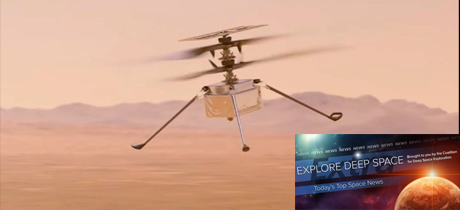Today’s Deep Space Extra… The Senate on Tuesday passed the U.S. Innovation and Competition Act, which includes a NASA authorization bill and the SPACE Act.
Human Space Flight
Senate passes NASA Authorization, SSA legislation as part of sweeping China competition bill
SpacePolicyOnline.com (6/8) The Senate yesterday passed S.1260, or the U.S. Innovation and Competition Act (USICA), which aims to confront competition from China by increasing funding for science and technology. Included in the bill are a NASA authorization act and the SPACE Act, which assigns civil space situational awareness (SSA) responsibilities to the Department of Commerce. Last year the Senate passed a NASA authorization bill, and the Senate Commerce Committee approved a SPACE Act, but time ran out for final passage of the bills before the end of the past Congress. Senators Maria Cantwell (D-WA) and Roger Wicker (R-MS) inserted versions of those bills into S.1260. The NASA authorization act inserted in S.1260 requires NASA to fund at least two companies to build Human Landing Systems (HLS) for the Artemis program, and authorizes $10 billion over five years to pay for it. The funds would have to be appropriated annually. NASA in April selected only one company to build the HLS for the first human lunar landing under the Artemis initiative. While the bill asks NASA to select more than one company, it also directs it to protect its current choice. NASA Administrator Bill Nelson issued a statement commending the Senate for its passage of the legislation. The bill, formerly known as the Endless Frontier Act, now heads to the House.
Roscosmos, CNES heads discuss France’s prospects to join Russian – Chinese lunar project
TASS of Russia (6/8): The heads of the Russian and French space agencies spoke virtually on Tuesday. The topics included possible further discussion on French participation in a Russian/Chinese-led International Lunar Research Station (ILRS). (Editor’s note: TASS is a Russian government-owned news source).
Space Science
Mars helicopter Ingenuity aces 7th on the Red Planet
Space.com (6/9): NASA’s Mars helicopter Ingenuity now has seven Red Planet flights under its belt. The 4-lb. (1.8 kilograms) chopper took to the Martian skies again on Sunday, making its first sortie since battling through an anomaly on May 22. Ingenuity deployed from Perseverance’s belly on April 3. That milestone started the clock ticking on the helicopter’s 30-day flight campaign, which was designed to show that powered, controlled flight, is possible in the Mars’ thin air. After the technology-demonstrating campaign, the helicopter then embarked on an extended mission, which aims to showcase the scouting potential of Martian rotorcraft.
Astronomers find organic compounds inside multiple dying stars
Futurism.com (6/8): In a surprise find, astronomers note the presence of complex and even organic chemistry in the radio emissions from sun-like stars as they enter the end-of-life phase and detonate. Evidence for such emissions from five different planetary nebulae within the Milky Way galaxy were presented Tuesday at a meeting of the American Astronomical Society. It may be that young planetary systems do not have to start from scratch when it comes to the formation of organics, the carbon rich chemistry essential to life.
Other News
Colorado lawmakers invite VP Harris to tour space facilities
SpaceNews.com (6/9): A group of lawmakers from Colorado in a June 9 letter urge Vice President Kamala Harris to visit military and space industry facilities in the state as she prepares to take over as chair of the National Space Council. “As you work to identify the council’s priorities, we invite you to visit Colorado to experience firsthand the dynamism of our state’s private and public space industry,” the lawmakers wrote in the letter, which was signed by Senators Michael Bennet (D) and John Hickenlooper (D), and Representatives Doug Lamborn (R), Joe Neguse (D), Jason Crow (D), Ed Perlmutter (D), Diana DeGette (D) and Ken Buck (R).
NASA astrophysics director to step down
SpaceNews.com (6/8): Paul Hertz, who has led NASA’s astrophysics programs since 2012, will step down by the end of the year to pursue another challenge within the agency. Hertz won support at NASA and in the astrophysics community for running a broad program that ranges from flagship-class space telescopes to Explorer-class small missions and smallsats. His successor will lead the implementation of the recommendations of the 2020 decadal survey.

